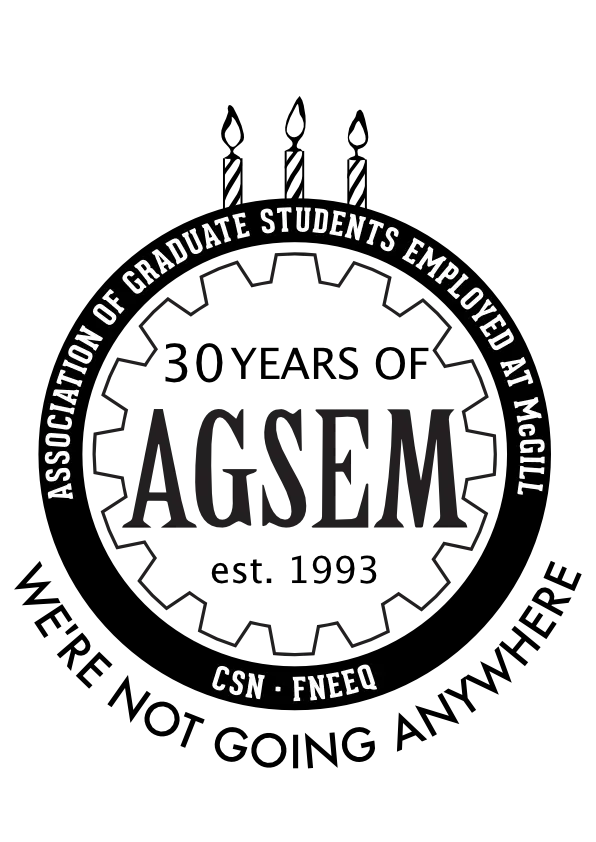Exhibit 2 - McGill Graduate TAs Unionize, AGSEM is Born (1993-1998)
Location of physical exhibit: On the first landing up the stairs towards Arts West. The display is on half of a bulletin board belonging to the Art History and Communication Studies Department.
After a meeting of graduate Teaching Assistants coordinated by the Post Graduate Students’ Society (PGSS) in the Fall of 1990, the Teaching Assistants’ Organizing Committee (TAOC) of PGSS was revived and given a new mandate to investigate the lack of progress in improving TA working conditions. Their research revealed major disparities in working conditions within and between departments, as well as between McGill and other Canadian universities. Among the graduate student workers polled in this period, 71% were willing to join an association of employees that could negotiate collectively for more equitable working conditions for all TAs.
“Tamara [Myers] organized a meeting at Thomson House and we were kind of sly about it. (Our major problem was that we didn’t know how many TAs there were on campus - that information was not centralized so that’s why we needed the department admin staff to forward us the names of who was a TA. We couldn’t organize without knowing numbers.) We contacted the administrative staff at each department and we said something really vague about just wanting to meet up at Thomson House with some TAs, do you have any names? We didn’t tell them why and so we got names from across campus and we invited them all in the Fall of 1990. The ballroom was at capacity, full of graduate students working as TAs. I presented the Schulze Report, [and said,] “Now we want to hear from you.” One by one people put up their hands and talked about what it was like working at McGill and it was really quite remarkable the stories we heard from every department.
People weren’t getting paid, or you might get paid a stipend which is essentially nothing. […] What was remarkable was that […] we honestly weren’t sure what we were going to get, we just wanted to meet TAs and learn more about their working conditions. But after a whole evening of people being angry, very concerned, very upset about what it was like to work at McGill, at the end of the evening someone said ‘well let’s just form a union’ and we wanted to know who would be interested in organizing and it seemed like everyone raised their hands.”
—Interview with Michael Temelini, PGSS President (1990-91), Teaching Assistants' Organizing Committee (TAOC), AGSEM’s First TA Bargaining Committee (1993-1997)
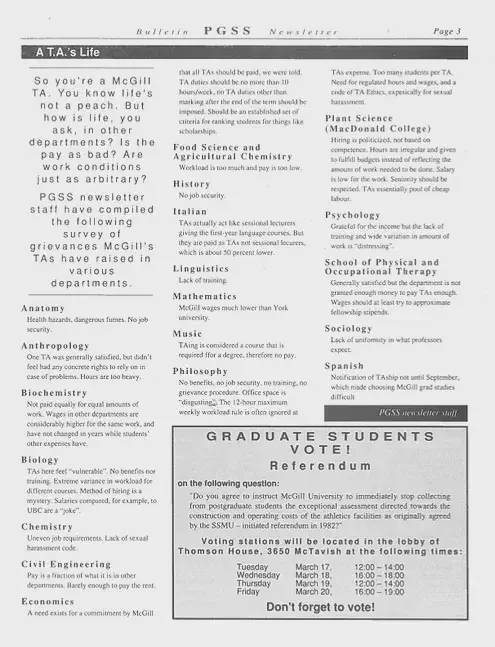
PGSS survey of TA grievances raised in various McGill departments, PGSS Newsletter Vol. 8 No. 5 (March 1992). AGSEM Archives, Vol. 4.1 “Posters and Communications.”
On February 12, 1992, the Association of Graduate Students Employed at McGill (AGSEM) was founded by the TAOC, and the TAOC was dissolved. AGSEM, as a labour union, formally split from the PGSS student union. A card-signing drive began in an effort to affiliate with the Fédération Nationale des Enseignantes et Enseignants du Québec (FNEEQ) of the Confédération des syndicats nationaux (CSN), a progressive trade union federation.
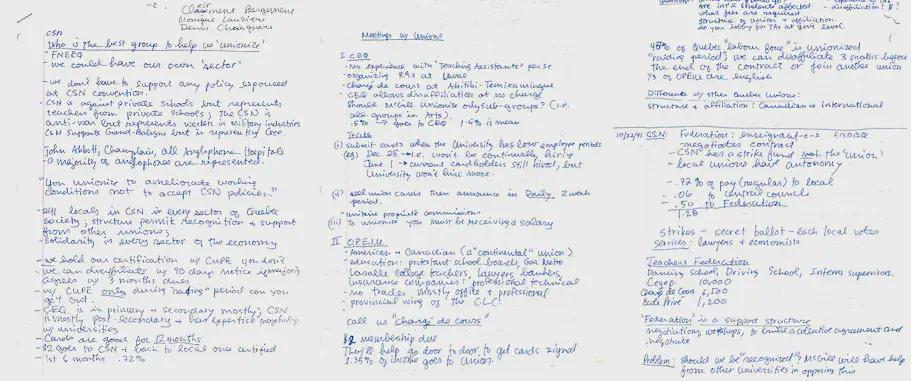
Handwritten notes by an AGSEM organizer from meetings with different potential parent unions: CEQ, OPEIU, CSN (1991). AGSEM Archives, Vol. 4.1 “Affiliation to CSN.”
“One of the fun things we had to do was figure out which union we want to work with to help us organize McGill campus. We thought we might go with the same union as York or Carleton, but then somebody had the idea of affiliating with CSN. You know it’ll strike fear into McGill. CSN was a bit of a radical union, and its head office was located in Montreal. We interviewed all these different unions and the CSN was very enthusiastic, they said we’d be their largest English speaking local, ‘we’ll affiliate you with FNEEQ, we’ll give you your own coordinator,’ CSN was very good to us. And we just thought… what statement would that make? These were early days, the 1995 referendum hadn’t happened yet, it was around the time of the Charlottetown Accord, there was a lot of tension around national unity in Canada and the Québec question. So we thought: let’s make a statement. Let’s go with a radical Québec-based union that has no TAs.”
—Interview with Michael Temelini, PGSS President (1990-91), Teaching Assistants' Organizing Committee (TAOC), AGSEM’s First TA Bargaining Committee (1993-1997)
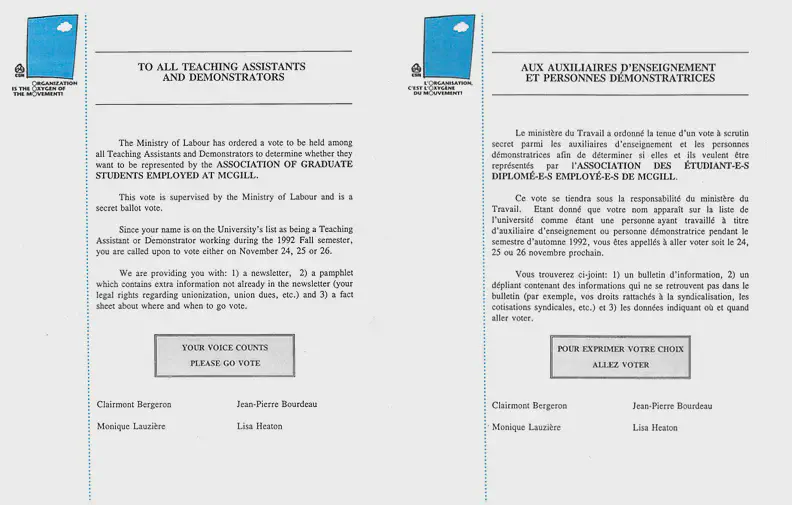
Poster advertising referendum to certify with CSN (November 1992). AGSEM Archives, Vol. 4.1 “Posters and Communications.”
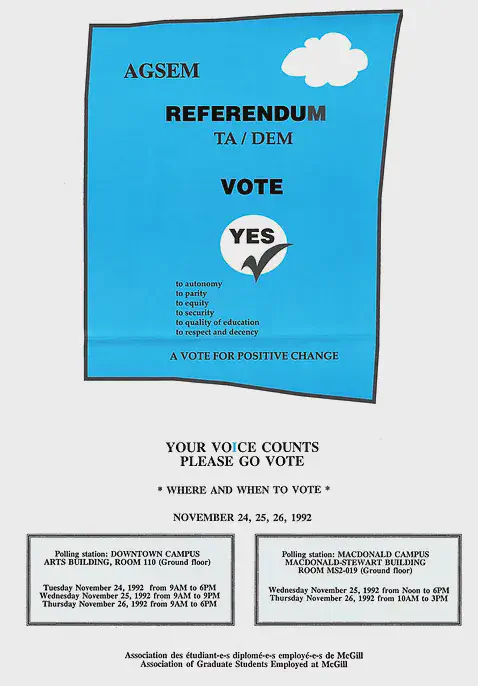
Poster advertising referendum to certify with CSN (November 1992). AGSEM Archives, Vol. 4.1 “Posters and Communications.”
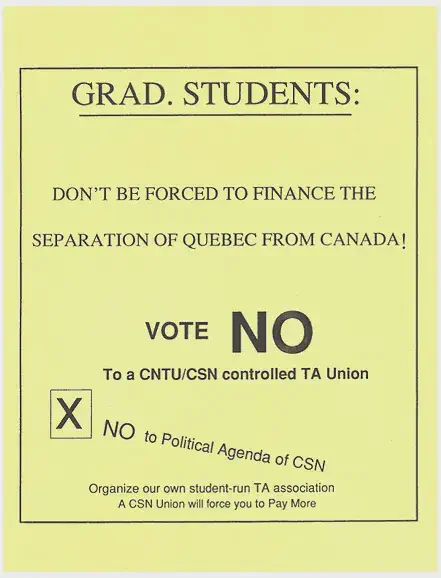
Pamphlet encouraging graduate students to vote against AGSEM’s certification with CSN (1992). AGSEM Archives, Vol. 4.1 “Posters and Communications.”
On August 4, 1992, AGSEM formally requested accreditation from the Quebec Labour Board by submitting its membership cards. Under Quebec labour law, there are two routes to certification The first possible route is taken with card-signing alone. The law states that if a group of workers is able to obtain 50% + 1 of all the signatures of the workers in a bargaining unit, the union will be automatically certified. If that group is only able to obtain between 35–50% of all the signatures, then a referendum is ordered and 50% of all workers have to vote in favour of the union in order for it to be accredited. As the AGSEM drive had fewer than 50% of cards, a referendum was held over three days between November and December 1992 on the question of whether or not to form a TA union. An absolute majority of TAs vote in favour. Despite the high turnover of McGill TA labour force, AGSEM wins the certification vote. On January 11,1993, the Labour Commission granted the certification of AGSEM, empowering it to negotiate on behalf of all graduate students employed as Teaching Assistants and Lab Demonstrators on the downtown and Macdonald campuses except those paid from “special” (research) funds.
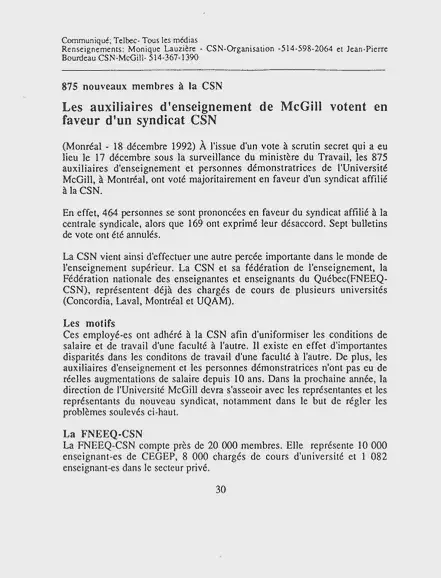
Press release announcing AGSEM’s certification with CSN (1992). AGSEM Archives, Vol. 6.1 “AGSEM Certification.”
“There were some issues around, you know, what does the union mean and will we have to go on strike. And we didn’t beat around the bush. We made it clear to people that… you look at the wages, you look at the lack of job security, the fact that the university refuses to negotiate in good faith at all, there’s no grievance procedures, there’s basically no rights for workers. And when people asked about a strike, we made it clear to people that the power of a union is collective action and removing our labour is the ultimate power that we have as workers. If we have to remove our labour, if we have to strike, then we’ll strike, but we don’t want to strike. No union wants to strike. That’s not the goal of a union. The goal of a union is a contract, a collective agreement. And we made that clear to people. If the university bargains in good faith, our goal is to get a contract. Our aim is not to disrupt McGill. People appreciated that, even people who were a little uneasy about what a union means. We were trying to be as honest and straightforward and lay all our cards on the table.”
—Interview with Michael Temelini, PGSS President (1990-91), Teaching Assistants' Organizing Committee (TAOC), AGSEM’s First TA Bargaining Committee (1993-1997)
Following the successful certification vote, AGSEM held its first General Assembly, a deliberative meeting open to all members, on February 17, 1993. At this meeting, TAs voted to adopt the constitution and elect the Bargaining Committee and the Coordinating Committee. Over the next months, the first collective agreement proposal was written by the AGSEM Bargaining Committee with three aims in mind: 1) The collective agreement had to be representative of membership demands; 2) The collective agreement had to put McGill TAs on equal footing with other unionized TAs in Canada; 3) The proposal had to be one that could be negotiated and settled with McGill in a timely manner.
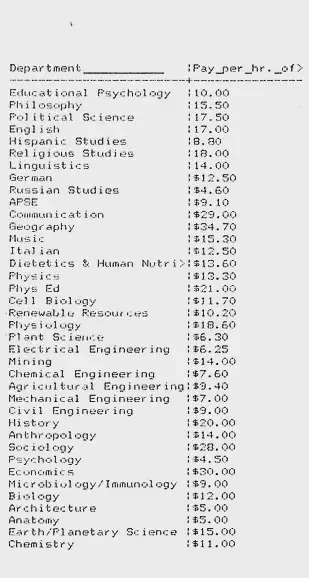
List of TA hourly pay at McGill per Department circa 1993. AGSEM Archives, Vol. 3.1 “Early Negotiation Documents.”
The first AGSEM Bargaining Committee would eventually succeed on the first aim, and make significant progress towards the second. Unfortunately, McGill was not amenable to negotiating AGSEM’s demands and frequently stalled negotiations. After two years of negotiations, the employer refused to submit its monetary offer to the union. To force McGill to put a number on the table, AGSEM called a General Assembly and on February 9, 1996 the union held its first strike vote. A one-day strike mandate was passed with 65% support. The strike mandate was largely symbolic, but with the intent of pressuring McGill to take the negotiations more seriously. This tactic proved to be successful–McGill finally tabled their monetary offer in early March 1996.
McGill’s monetary proposal included two categories: Teaching Assistant 1–which included graders, markers, and demonstrators–and Teaching Assistant 2–which included conference and practicum leaders. TAs from the first category offered $10 per hour, while TAs from the second category were offered $15 per hour. AGSEM rejected their proposal based on the grounds that their proposed description did not reflect all duties performed by TAs, nor was the pay fair. McGill responded by stating that the pay was fair based on the rate of pay at other universities in Quebec.
On March 19, 1996, AGSEM exercised its strike mandate and held a one-day strike. This was the first legal strike of academic workers at McGill. It was successful at mobilizing membership to vote 80% in favour for another one-day strike in Fall 1996 in case negotiations did not progress over the summer. After negotiations stalled once again at the end of summer, AGSEM informed the employer that it was planning to request binding arbitration from the Minister of Labour to settle all unresolved issues. Additionally, AGSEM called for a general strike vote on November 27, 1996. The vote failed, but it was close (108 for, 111 against, and 1 spoiled ballot). Many members felt unable to bear the financial burden of a strike, preferring to wait for the outcome of a binding arbitration.




AGSEM members picket Roddick Gates during the 1996 strike. AGSEM Archives, Vol. 4.1 “‘AGSEM Strike Photos.”
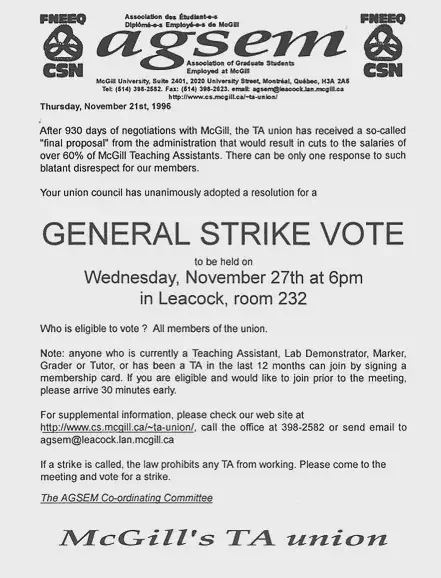
AGSEM general strike vote announcement (November 1996). AGSEM Archives, Vol. 3.1 “TA strike correspondence and flyers.” AGSEM Archives, Vol. 4.1 “Posters and Communications.”
“Many of those who voted against the strike did so because of the financial and emotional sacrifices required by strike action; the strike would have required a substantial pay cut for those who depended on their TAships. It is unfortunate that the very situation of poverty that we are attempting to remedy prevents us from using a union’s most important pressure tactic, but that is the reality we face.”
—Regina Harrison and Michael Temelini, Joint Co-ordinators 1996-1997, General Strike Vote Results, November 28, 1996.
The process of appointing an arbitrator took four months. From March until November 1997 negotiations with the arbitrator proceeded until the arbitrator assigned to the case was unable to continue in the role. Waiting for another arbitrator and going through the process again would likely have added another year to negotiations. It was at this point that McGill began to make serious salary offers, appearing to decide that four and a half years of negotiations was too long.
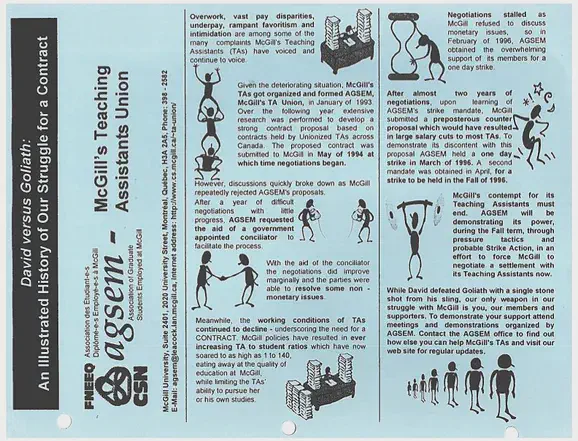
“David versus Goliath: An Illustrated History of Our Struggle for a Contract,” AGSEM pamphlet (1997). AGSEM Archives, Vol. 3.1 “1997 Bargaining Documents.”
When the first collective agreement was finally ratified by TAs at an Assembly on March 5, 1998, one thousand four hundred (1400) days had passed since AGSEM started negotiating with McGill. The first contract was finally reached, bringing regulations to TA workload and eventual TA salary parity across the university. The lowest pay rate at the time was $7 for Anatomy TAs, while the highest-paid Arts TAs made $18.13. The contract did not meet all of the union’s expectations, with regard to low pay, overwork, workplace safety, and harassment. Nevertheless, the agreement did supply salary increases, a strong grievance procedure, safer working environments, and some protections for excessive workloads. The one-day strike in 1996 also set a very important precedent for pressure tactics for TA negotiations to come.
“AGSEM was the first teaching assistants’ union in Québec but it wasn’t the first in Canada. We knew there were other TA unions in Canada. The two most prominent was at York University, which was for us the gold standards. It also caused problems for us because… we should have aimed for a really simple first contract and then go for the moon, but instead we said ‘we want what York has’ and it dragged on the process for so long. It took us 4 or 5 years to do that and it was a bit dangerous too. In the first contract, if you don’t keep your membership base at 50% +1, then the employer could request a decertification. So what we should have said is that on our first contract, we’re going to get a simple bare bones agreement. But we wanted what York had and it created a prolonged process and McGill didn’t want anything to do with it. McGill was a nasty bargaining partner.”
—Interview with Michael Temelini, PGSS President (1990-91), Teaching Assistants' Organizing Committee (TAOC), AGSEM’s First TA Bargaining Committee (1993-1997)
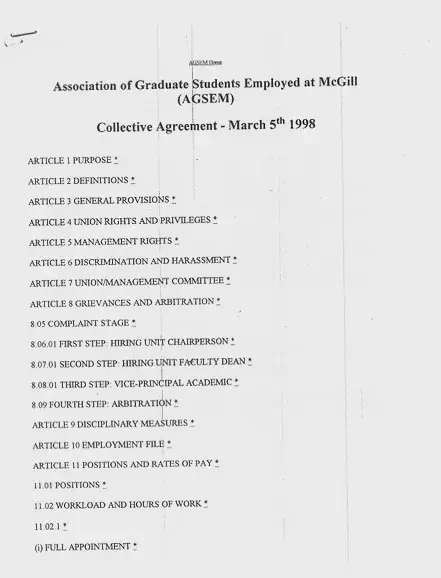
First AGSEM Collective Agreement with McGill (March 1998). AGSEM Archives, Vol. 3.1 “First Collective Agreement TA Bargaining.”
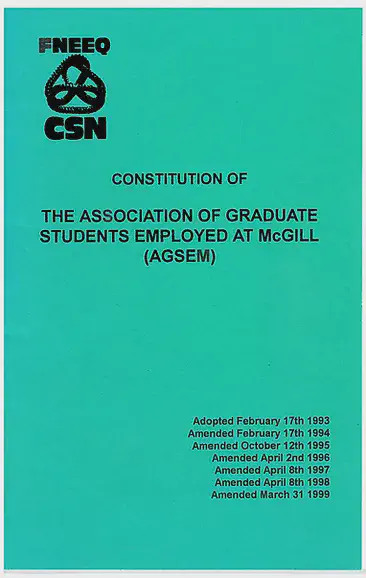
Constitution of The Association of Graduate Students Employed at McGill (AGSEM) with amendments (1999). AGSEM Archives, Vol. 6.1 “AGSEM Constitutions.”
